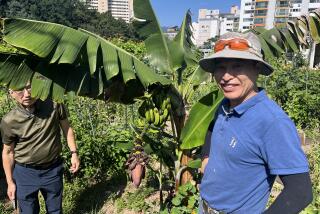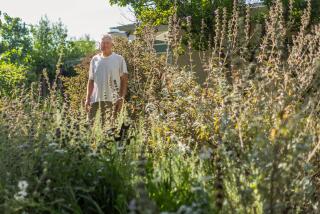A Bunch of Damage : December Freeze Leaves Its Mark On County Farmer’s Banana Plantation
- Share via
As his banana harvests grew ever more bountiful, Doug Richardson silenced skeptics who claimed the subtropical fruit could not be grown in the continental United States.
But in each of the past five winters, the pioneering farmer harbored a fear that a rare frost would descend on his Seaside Banana Garden and prove the naysayers correct.
In December, one of the century’s worst freezes enveloped California. It decimated 30% of Richardson’s 12-acre crop in La Conchita, and the entire yield of a more recently cultivated six-acre grove in nearby Carpinteria.
Despite losing an estimated $100,000 worth of fruit, Richardson is not overcome by the setback. The freeze has provided the self-taught farmer a chance to see which of the exotic bananas he grows can best weather the travails of the temperate zone.
“We’ve got over 50 varieties, and the genetics of each one are different,” Richardson, a former landscape contractor, said. “This really is an open-air laboratory.”
“Many of the varieties he’s growing have never even been studied,” said Ben Faber, a farm adviser for the University of California Cooperative Extension who specializes in subtropical crops.
Ensconced in a balmy area of coastal Ventura County, the Seaside Banana Garden is the only commercial banana plantation in the continental United States, according to the International Banana Assn.
With a microclimate created by warm Pacific Ocean breezes, the plantation at the base of 300-foot-high coastal bluffs is generally cloistered from frost. Temperatures run 8 to 15 degrees higher than in Santa Barbara and Ventura, both about 15 miles away.
Longtime residents assured Richardson and his partner, Paul Turner, when they began their venture in 1985 that the last time the area experienced freezing temperatures was in 1937, during one of the most severe California cold spells on record.
Banana plantations usually are found in subtropical regions of Central and South America, Asia and Africa where temperatures rarely dip below 55 degrees. The common variety of bananas sold in American supermarkets, the Cavendish, is among the most sensitive varieties. Its plant and fruit stop growing at 50 degrees, suffer damage in the low 40s, and die when the weather drops into the 30s, Richardson said.
But 90% of the 10,000 trees in the Seaside Banana Garden are rare varieties such as the Iholena, Blue Java and Red Jamaican, most of which grow at 2,000-foot elevations. “Highland bananas are not as susceptible to cold as the normal variety,” Faber said.
On the night of Dec. 21, when the arctic cold front hit, temperatures fell to 15 degrees in Santa Barbara and to 22 degrees in Ventura. They dropped to 32 degrees at La Conchita from 9 to 10 p.m. before reaching the mid-30s for the rest of the night.
Richardson said that single hour of freezing weather was enough to damage some of the La Conchita trees, about a third of which still have brown leaves and weakened trunks.
“We lost a big chunk, but we’ll still have more fruit than we did last year,” said Richardson, who produced 125 tons of bananas last year. “There were large areas that were virtually untouched.”
In Carpinteria, Richardson’s groves did not fare as well, with temperatures dropping to 29 degrees throughout the night. Half of the crop there is Cavendish. The entire crop was destroyed.
Since the Carpinteria trees will not produce fruit for one to two years, Richardson has decided to harvest their leaves and sell them as Mexican tamale wrappings. Banana leaves impart a better flavor and aroma than corn husks, and unlike imported leaves, his bear no pesticides or chemical preservatives, he said.
“We didn’t like sacrificing leaves before, because without them the fruit wouldn’t fill out,” said Richardson, whose bananas bring $1.50 to $4 per pound. “But they could turn out to be just as profitable as the bananas.”
About 30% of the La Conchita crop already has been written off because it has an off-flavor, appears scorched and has skin that sticks to the fruit or pulp with a hard and crunchy texture.
An undetermined percentage of the crop will suffer cosmetic damage, its skin ripening to a yellow-brown rather than bright yellow. Richardson said he will be able to sell that fruit from his thatched-roof stand at the Seaside Banana Garden. Most of his crop is sold at organic food stores and exclusive restaurants nationwide.
All the fruit still hangs in bunches on the trees so Richardson can determine which ones have lower yields because of the freeze, and which ones bear fruit that can mature from nutrients in plants whose leaves have all but died.
With that knowledge, Richardson said, he will be better armed for nature’s next frontal attack on his groves.
More to Read
Sign up for Essential California
The most important California stories and recommendations in your inbox every morning.
You may occasionally receive promotional content from the Los Angeles Times.










